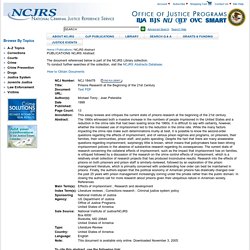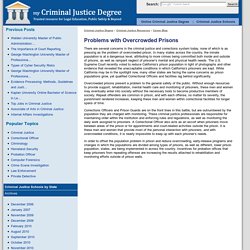

Program: Adolescent Diversion Project (Michigan State University) - CrimeSolutions.gov. Evidence Rating: Effective - More than one study Program Description Program GoalsThe Adolescent Diversion Project (ADP) is a strengths-based, university-led program that diverts arrested youth from formal processing in the juvenile justice system and provides them with community-based services.

Based upon a combination of theoretical perspectives, the goal of the ADP is to prevent future delinquency by strengthening youth’s attachment to family and other prosocial individuals, increasing youth’s access to resources in the community, and keeping youth from potentially stigmatizing social contexts (such as the juvenile justice system). The program began in 1976, through a collaboration among Michigan State University, personnel from the Ingham County (Mich.) Juvenile Court, and members of the community in response to a rise in juvenile crime and the need for cost-saving alternatives to the formal processing of juveniles.
Evaluation Outcomes Evaluation Methodology Cost Additional References. Ingham County Adolescent Diversion Project. J005v27n02_03# The adolescent diversion project: 25 Years of research on an ecological model of intervention - Michigan State University - SciVal Experts 4.6. Scopus Publication Detail The publication detail shows the title, authors (with indicators showing other profiled authors), information on the publishing organization, abstract and a link to the article in Scopus.

This abstract is what is used to create the fingerprint of the publication. 11 Tips on How to Present Research Findings. All Programs & Practices - CrimeSolutions.gov. Home | Help | Contact Us | Site Map | Glossary Advanced Search Additional Resources: <div id="sub_icons_js"><a href="emailupdates.aspx"><img src="images/gov_delivery_icon.gif" alt="Subscribe for updates" title="Subscribe for updates" align="absbottom" class="image_nb" /></a><img src="images/line.jpg" alt="" width="16" height="23" class="image_nb"/><a href="javascript:window.print()"><img src="images/1_print_icon.jpg" alt="Print icon" title="Print icon" width="30" height="29" align="absbottom" class="image_nb" /></a><img src="images/line.jpg" alt="" width="16" height="23" class="image_nb" /><a href="mailto:?

Home > All Programs & Practices. Useful Criminal Justice Research and Evaluation Sites. How to estimate your population and survey sample size? Let us assume that you are a Market Research Manager at a furniture company and you are planning to launch a new furniture line at the end of 2013.

However, before you launch the new line you wish to conduct an online survey on whether your line ‘Fall – 2013’ is more or less likely to be a hit or miss on the European Union (EU) market. So far, so good. Yet, the following question will almost instantly arise: “What is the population that I would like to survey?”.
Or, who do you need to survey to gain valuable insights on the success of your new furniture line? In this case the answer is rather straightforward. For obvious reasons it is impossible to survey those (roughly) 400 million adults in the EU. Useful Criminal Justice Research and Evaluation Sites. National Institute of Justice. Research Agenda Our long-term research agenda is founded on our strategic goals that inform program-specific research objectives.

At the heart of our planning process is the need to balance the state of current research knowledge with the pressing needs of criminal justice practitioners and policymakers. Each of our portfolios (e.g., policing, corrections, information technology, violence, victimization, forensics research) pursues a research agenda that incorporates several kinds of knowledge-building activities. The activities include basic and applied research questions, program evaluation needs, and opportunities to develop and test new interventions and strategies.
NCJRS Abstract - National Criminal Justice Reference Service. Tools Advanced Search Search Help Menu.

NCJRS Abstract - National Criminal Justice Reference Service. Tools Advanced Search Search Help Menu.

Prison overcrowding is a growing concern in the U.S. Problems with Overcrowded Prisons - My Criminal Justice Degree. There are several concerns in the criminal justice and corrections system today, none of which is as pressing as the problem of overcrowded prison.

In many states across the country, the inmate population is at a dangerous level, attributing to more crimes being committed both inside and outside of prisons, as well as rampant neglect of prisoner’s mental and physical health needs. The U.S. Supreme Court recently voted to reduce California’s prison population in light of photographs and other evidence that revealed the unacceptable conditions in which California’s prisoners are kept. While California may be in the spotlight now, many other states are facing the same concerns as prison populations grow, yet qualified Correctional Officers and facilities lag behind significantly.
Overcrowded prisons present a problem to the general safety of the public. Labels: careers, correctional officer, prisons. Criminal Justice System Study. What causes jail overcrowding?

The purpose of most criminal justice system studies is to identify how to reduce jail overcrowding. There are two conditions that affect overcrowding: (1) The number of people brought to jail and (2) their length of stay. Prison overcrowding - Penal Reform International. Prison overcrowding is one of the key contributing factors to poor prison conditions around the world.

It is also arguably the biggest single problem facing prison systems and its consequences can at worst be life-threatening at best prevent prisons from fulfilling their proper function. Data suggests that the number of prisoners exceeds official prison capacity in at least 114 countries. Overcrowding is a consequence of criminal justice policy not of rising crime rates, and undermines the ability of prison systems to meet basic human needs, such as healthcare, food, and accommodation.
It also compromises the provision and effectiveness of rehabilitation programmes, educational and vocational training, and recreational activities. Viewpoints. The most expensive presidential election in history is over. In a campaign dominated by the economy, criminal justice issues played literally no role in either candidate’s campaign. From a political point of view, ignoring criminal justice issues was the right way to go.
California Sentencing Institute — Center on Juvenile and Criminal Justice. In 2009, CJCJ developed the California Sentencing Institute as the foundation for data and research driven commentary on the broader public policy dialogue. The interactive map presents detailed crime and incarceration numbers, rates, and trends for California and each of its 58 counties. This resource is designed to provide comprehensive analysis of sentencing policies and practices across the state. Visit the California Sentencing Institute >> Read related CJCJ publications, blogs and news >> Appendix C: Prison Crowding. Sign In. Publications All Publications. German Police Arrest 3 in Terrorist Plot.
Centers Tap Into Personal Databases. Intelligence centers run by states across the country have access to personal information about millions of Americans, including unlisted cellphone numbers, insurance claims, driver's license photographs and credit reports, according to a document obtained by The Washington Post. One center also has access to top-secret data systems at the CIA, the document shows, though it's not clear what information those systems contain. Dozens of the organizations known as fusion centers were created after the Sept. 11, 2001, terrorist attacks to identify potential threats and improve the way information is shared. The centers use law enforcement analysts and sophisticated computer systems to compile, or fuse, disparate tips and clues and pass along the refined information to other agencies.
Though officials have publicly discussed the fusion centers' importance to national security, they have generally declined to elaborate on the centers' activities. Using 911 Calls to Detect Terrorism Threats. By Kevin J. Strom, John Hollywood and Mark Pope Terrorists frequently engage in surveillance activities when selecting a target and planning an attack.[1] Needless to say, when we are able to spot such surveillance activities, we stand a greater chance of preventing an attack.
In 2007, for example, authorities thwarted a terrorist plot in Germany when they caught people surveying U.S. military facilities near Hanau.[2] In 2006, two men were charged with videotaping the U.S. Capitol building, the World Bank, a Masonic temple and a fuel depot in Washington, D.C., to send to overseas terrorist groups.[3] And in 2004, the U.S.
Department of Homeland Security raised the terrorist threat level following reports of terrorist surveillance of key financial institutions in New York City, New Jersey and Washington, D.C.[4] NCJRS Abstract - National Criminal Justice Reference Service. Tools Advanced Search Search Help Menu. Search Results - National Criminal Justice Reference Service. Program: CCTV in Philadelphia (Pa.) - CrimeSolutions.gov. Evidence Rating: Promising - One study Program Description Program Goals/Program Components The city of , , installed 18 closed-circuit television (CCTV) cameras at various locations in the city between July 2006 and November 2006 to help reduce crime. NCJRS Abstract - National Criminal Justice Reference Service. CCTV 'not a crime deterrent' CCTV is not as useful in the fight against crime as was previously thought, according to government research.
The cameras, which have been placed at the heart of crime prevention policy, may be more effective as a detection tool than as a deterrent, researchers found. Detection and Surveillance Technologies. Listening to the wire: criteria and techniques for the quantitative analysis of phone intercepts. This paper focuses on phone conversations wiretapped by the police. Technology Research, Development, Testing, and Evaluation Process. National Institute of Justice. National Criminal Justice Reference Service. Synthesis Matrix for Literature Review. Sep 01, 2013 by Dr Sally. Literature Review Synthesis Examples. S Multisite Adult Drug Court Evaluation. Research to Practice Initiative.
NIJ's Multisite Adult Drug Court Evaluation. Quantitative Research Design. Types of Study Samples Sample Size What to Measure Quantitative research is all about quantifying relationships between variables. Variables are things like weight, performance, time, and treatment. You measure variables on a sample of subjects, which can be tissues, cells, animals, or humans. You express the relationship between variable using effect statistics, such as correlations, relative frequencies, or differences between means. Violence Against American Indian and Alaska Native Women: Secondary Data Analysis. In Brief: Expanding Research by Sharing Data.
Domestic Violence and the Criminal Justice System: An Overview. Sleep Disorders, Work Shifts and Officer Wellness. 10-Hour Shifts Offer Cost Savings and Other Benefits to Law Enforcement Agencies. 10-Hour Shifts Offer Cost Savings and Other Benefits to Law Enforcement Agencies. Publications All Publications.